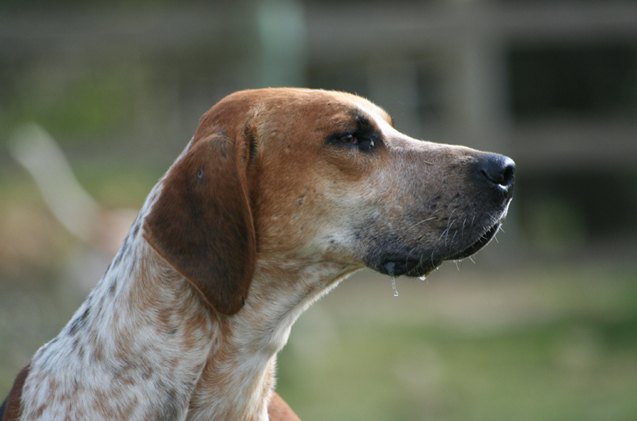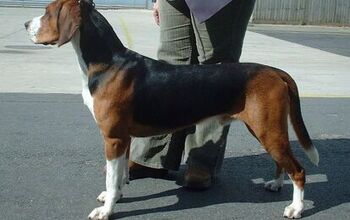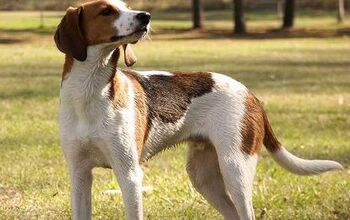English Foxhound


About English Foxhound
If there was ever a dog suited for suited for the highly active athlete or sportsman, it is the English Foxhound. Originally bred as a hunting dog, the English Foxhound is an iconic symbol of the British Hunt. They are somewhat similar in appearance to Beagles and have the distinctive black, white and tan body colorations. Their ears are drooping and hang close to their heads. Their tales on the other hand are strong and erect and end off in a sharp point. The English Foxhound is a strongly built breed and has strong-boned, muscular legs, all giving it the appearance of a well-chiseled athlete.
The English Foxhound was bred for its hunting and tracking abilities. It is strong, determined and tenacious, making it an excellent field dog. They are also highly sociable creatures and make excellent companions for highly active owners. However, English Foxhounds bred for the show ring might be a better option for owners looking for a more laid-back Foxhound. And although smaller creatures might stir up their prey instincts, these dogs generally get along excellently with other animals and pets.
Originally bred as a hunting dog, the English Foxhound is an iconic symbol of the British Hunt.
The English Foxhound was England’s answer to Britain’s depleting deer population. In the early 1600s, deer was hunted heavily in England both for food and for sport, which resulted in a fast decline of the species’ population; which in turn led the British to pursue a different type of hunt: the fox hunt. This called for a hunting dog with speed, great stamina and a keen sense of smell; all characteristics that the English Foxhound possesses. During the British Raj, English Foxhound’s were used in India for Jackal coursing, but did not enjoy long life spans due to the significantly hotter climate.
This breed was created by crossing greyhounds for their speed, fox terriers for their hunting instincts and bulldogs for their great resolve during hunting.
English Foxhounds are highly active dogs and require a nutritious diet. They should be fed 2-3 cups of high quality dry food in two sittings per day.
Like most other hound breeds, English Foxhounds are highly independent and can sometimes be stubborn.
Like most other hound breeds, English Foxhounds are highly independent and can sometimes be stubborn. Therefore they require firm, assertive leadership and consistent training. They are also bred to hunt in packs and require this firm leadership to be well-balanced. Obedience training can however take time and patience. Owners may experience trouble with the “come” command, especially when walking this dog without a leash. Their prey instincts are easily aroused and they can run off in pursuit of interesting ‘prey’ if walked off leash.
The ideal weight for a full-grown English Foxhound ranges from 55 to 75 pounds.
As with most other high energy hunting breeds, the English Foxhound responds well to owners that are calm and assertive. They require rules, boundaries and limitations as well as love and will be extremely happy when provided with consistent leadership.
As with most other working dogs, English Foxhounds can become bored and eventually destructive when not provided with a ‘meaningful’ task. Therefore it is important that they be given mentally challenging jobs as well as physically challenging ones.
English Foxhounds were bred to work in packs and with humans, and are therefore highly sociable animals. They get along well with children and other large animals like horses. They can sometimes chase smaller animals that they view as prey if they are not given boundaries and rules early on.
English Foxhounds have a loud, baying bark, which is a desirable characteristic in a guard dog. However, they do not have the protective instincts of other guard dog breeds.
English Foxhounds, like most other large and active breeds are prone to hip dysplasia and should be examined regularly for joint problems as the dog ages. They are also known to occasionally suffer from kidney disease and epileptic fits. The latter is a hereditary disorder that cannot be completely cured but can be treated with medication.
A healthy English Foxhound has an average life span of 10-13 years.
This breed has very high levels of energy and has been bred to be able to run continuously throughout the day with only a few breaks. Therefore it is extremely important to exercise it daily for at least an hour. If you are an avid marathon runner, jogger, hiker or cyclist, an English Foxhound will make an excellent exercise companion. When not exercised sufficiently these dogs can turn stubborn and destructive.
English Foxhounds were bred to work in packs and with humans, and are therefore highly sociable animals.
The AKC has this to say on English Foxhounds: A versatile dog, he can be trained to hunt almost any ground game. In appearance, the English Foxhound is any good “hound color,” which includes black, tan, and white, or any combination of these three. Although similar in appearance to his American Foxhound cousin, the English version is shorter and much stouter in appearance. The English Foxhound was recognized by the AKC in 1909.
The English Foxhound’s coat is thick, short and shiny and should be brushed weekly with a rough cloth or hound mitt to remove excess hair. This is as much grooming as the English Foxhound needs and should be bathed occasionally if particularly dirty or smelly.
Like most independent, high energy breeds of dogs, English Foxhound puppies should be socialized from a very early age. They should also be trained to accept grooming efforts early on to ensure that it will remain a pleasant experience throughout the dog’s life.
Photo credit: Thowra_uk/Flickr; Luna04/Wikimedia; Llima Orosa/Flickr

Amy Tokic, Editor of PetGuide.com, is a passionate animal lover and proud pet parent of Oscar, a Shih Tzu/Chihuahua cross, and Zed, a Japanese Chin. Her love of animals began in kindergarten, when she brought her stuffed dog Snoopy into class with her every day. Now, she writes about her adventures in pet ownership and tirelessly researches products, news and health related issues she can share with other animal enthusiasts. In her free time, Amy loves perusing used book and record stores, obsessing over the latest pet products available and chasing squirrels with wild abandon (a habit attributed to spending too much time with her pooches).
More by Amy Tokic

























